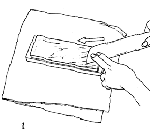Super-sharp and aesthetic too 1
There is plenty of reference material out there if you like to keep your kitchen knives really sharp. For example try Steve’s Knife Sharpening Links at http://users.ameritech.net/knives/links.htm
A sharp knife is safer (less likely to slip) than a blunt one, will increase your speed and generally be much more satisfing to use.
There are many techniques and tools in use. For culinary use I recommend whetstones lubricated with water.
My advice is as follows:
- allow at least 30mins per month in sharpening if you’re doing 4 knives
- get at least 3 good-sizes whetstones. The best ones, like Global’s ceramic stones or natural Japanese whetstones are expensive but last much better than man-made stones. This is what I use:
- coarse 250 grit for starting off really abused knives
- medium 800 grit, normally the first one you use to “raise the burr” (if you don’t know what this means, read this primer http://users.ameritech.net/knives/knives1c.htm)
- fine 5000 grit polishing stone
- extra fine 8000 grit polishing stone
“Combination stones” are common, where you get 2 grades, one on each face of the stone.
The idea is to start with a coarse or medium grit to remove the old edge and put a new one on. You know you’ve done it when you can feel the burr all the way along the edge of the blade on the side you’re NOT working on. When you’ve done it, repeat the process on the other side of the blade.
This picture (click to see in full)
from Shizuo Tsuji’s seminal textbook “Japanese Cooking: A Simple Art” shows the technique for using a whetstone.
Note that the illustration shows a traditional Japanese blade, sharpened on one side only, like a chisel. Western knives (including Global) are sharpened on both sides, into a “V” section, which is more robust though less sharp.
Once you’ve raised the burr, move onto finer grades of stone and go over your work, polishing and improving the edge. You will see it gleam. Pass the edge across your finger nail; when it’s sharp it will “grab” your nail. If it slides off, keep working.
Work with a gentle touch, especially once you’re in the polishing phase. Concentrate on keeping the angle of the knife against the stone constant.
The hardness of your knife affects the job; the harder the steel, the easier it is to sharpen and the longer it keeps its edge. If you’ve read Kitchen Confidential then you know Anthony Bourdain’s advice to throw away all your expensive Solingen knives (Henckels, Gustav Emil Ern, Wusthof etc) and buy a set of even more expensive Globals. Well, if money’s no object and you don’t miss the greater weight of the German tools for heavier tasks, then go ahead and take his advice because they are a lot less hassle.
Or like many Japanese cooks you may prefer carbon steel (i.e. not stainless) which are harder and again easier to sharpen and keep sharp. According to Shizuo Tsuji, who has taught a generation of cooks at his academy the Ecole Technique Hotcliere Tsuji in Osaka:
many Japanese chefs have two sets of steel knives, using them on alternate days. After honing, they let one set of knives rest for a day so that the “raw” metallic post-honing tastes have time to disappear from the blade’s edge.
And don’t forget this advice, from Tsuji again:
Where there are good knives, there should also be good chopping blocks… The best surface on which cutting can be done is wood… The best chopping blocks are boards with the grain running along the length of the board… There are also plastic boards which are sanitary and kind to knives, but are not aesthetic.

I just got this whetstone http://www.axminster.co.uk/king-japanese-combination-waterstones-prod22468/ its the cheapest place I’ve seen for getting them.